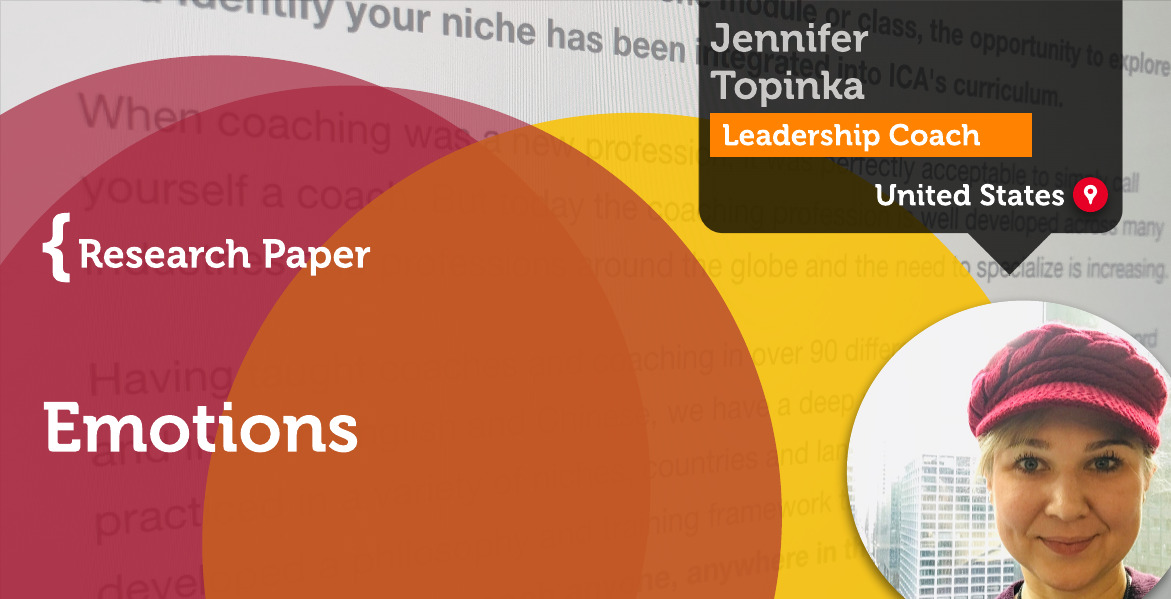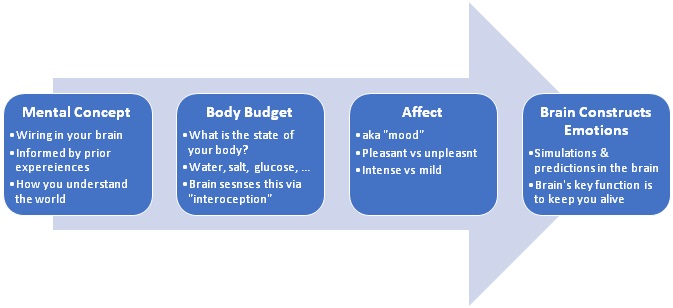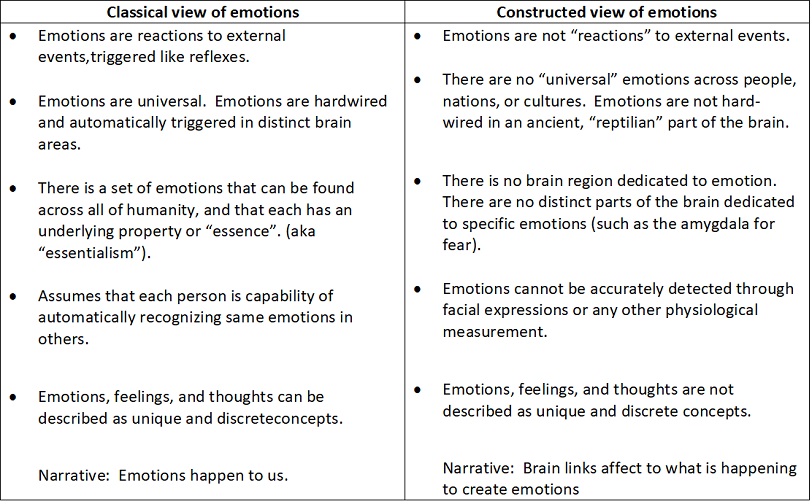A Research Paper By Jennifer Topinka, Internal Leadership Coach, UNITED STATES

How Emotions Are Made by Lisa Feldman Barrett
In my coaching evaluation (observed coaching), I received feedback that I missed opportunities to explore the clients’ emotions despite asking “how are you feeling?”. In this research paper, I set out to study emotions so that I could be more fluent and articulate while addressing emotions, feelings, and thoughts – both as a client and a coach. This led me to an unexpected journey to a new theory on emotions, specifically the “constructed emotion” view. I’ve based my research paper primarily on learning from How Emotions are Made, by Lisa Feldman Barrett.
My Learnings: Theory of Constructed Emotions
- There is not a single agreed theory of emotions and feelings in the professional community today.
- According to the theory of constructed emotion, humans shape their emotions based on their brain’s predictions and simulations. These predictions are shaped by prior experience, body budget, and mood.
- This new view of emotions provides insights into how to master emotions, both as a client and as a coach.
What is an emotion? There are two main theories of emotions, which can be referred to as:
- The classical view of emotions
- The theory of constructed emotions
The Classical View of Emotions
The classical view of emotions states that humans share an innate set of emotions and express them in roughly the same way. This theory views emotions as hardwired products of evolutionary instincts that motivate us to act to promote our survival. The plot of the Pixar movie Inside Out is based on this theory of emotions. In this movie, the emotions are characterized: Joy, Sadness, Fear, Anger, and Disgust. This has been the dominant view of emotions and is well-engrained into our society and cultural understanding of emotions. (Barrett, 2015)
According to the classical view, emotions are believed to originate in the subcortical region, the amygdala, and the ventromedial prefrontal cortices, which cause biochemical reactions to occur and change our physical state(Hampton, 2015). In this theory of emotions, the basic emotions are deeply ingrained in the human’s genetic code because it has helped us survive as species. Because emotions derive from a physiological reaction to a stimulus, they are unconscious and instinctive. According to research by Paul Ekman are at least 5 basic emotions that all humans can experience: happiness, sadness, fear, disgust, anger. Two additional universal emotions may be enjoyment and surprise. (Paul Ekman Group, 2021) The basic emotions are believed to correspond with distinct and universal facial features.
“Emotions are a process, a particular kind of automatic appraisal influenced by our evolutionary and personal past, in which we sense that something important to our welfare is occurring, and a set of psychological changes and emotional behaviors begins to deal with the situation.” – Paul Ekman, Ph.D. (Paul Ekman Group, 2021)
In the classical view of emotions, there are differences between emotion, feeling, and thoughts. (Hampton, 2015)
- Emotions – physiological responses occur in the body and are believed to arise from activity in three distinct regions of the brain. (Amygdala, Insula cortex, and midbrain called the periaqueductal gray).
- Feelings- mental experiences of body states and arise as your brain interprets the subconscious emotions. Feelings are believed to originate in the neocortical region of the brain.
- Thoughts – Mental processes that serve as the link between our emotions and feelings. They represent beliefs, opinions, and ideas.
The Theory of Constructed Emotions
There is a second theory of emotions indicating that emotions are not universal, but rather learned and shaped by culture. Dr. Lisa Feldman Barrett, a psychologist and neuroscientist is a leading proponent of this view and coined the term “constructed emotions”. She postulates that emotions are not reactions to the world rather the brain’s way of making meaning in a specific context. In this theory, your brain makes emotions, emotions are not written in your body. They are constructed by your brain, hence the name of the theory, Constructed Emotion Theory.
Emotions are not reactions to the world. You are not a passive receiver of sensory input but an active constructor of your emotions. From sensory input and experience, your brain constructs meaning and prescribes action. If you didn’t have concepts that represent your experience, all your sensory inputs would just be noise. You wouldn’t know what the sensations are, what caused them, nor how to behave to deal with them. (Feldman Barrett, 2017)
Dr. Barrett’s research has shown that predicted expressions of emotions are not universal. (Waikato, 2020)She found that previous studies indicating there is a universal set of emotions relayed on the fact that people first had the conventional concept of emotions. By testing people in tribes without similar concepts of emotions, as well as babies, the classic theory of universal emotions could not be replicated in scientific experiments.
In the constructed view of emotions, there is not necessarily a differentiation between emotions, feelings, and thinking. Dr. Barrett rather describes key terms to rebuild the understanding of emotions: Affect, Interoception, and Body Budget. Affect is like mood. Simple pleasant and unpleasant effects come from an ongoing process called Interoception. Interoception is the brain’s representation of all sensations from inside the body (internal organs, tissues, hormones, etc.). The interoceptive activity produces the spectrum of basic feelings from pleasant to unpleasant, calm, jittery, or neutral. Interoception is one core ingredients of what we recognize as emotion. Body budget refers to the state of your body, which is impacted by movement, nutrition, hydration, sleep, etc.
In the constructed emotion view, the full emotion experience is driven by the brain’s predictions and simulations. The brain, trapped in the skull, has the sensory input from the body (Interoception), other sensory information coming from the external world, and past experiences. Through prediction, the brain constructs the world as we experience it and assigns meaning. These predictions are also informed by our mental concepts. Concepts are the primary tool for the brain to guess the meaning of the incoming source inputs.
Figure 1 – Key Elements of “Constructed Emotion” Theory

Summary of the Two Theories of Emotions

Mastering Emotions in the Coaching Application
In the theory of constructed emotions, we have a sense of personal responsibility. Emotions are determined by our brain, using the wiring in our brain (concepts) and available signals coming into our brain. We partially control our concepts, our body budget and therefore can influence our brains’ predictions and simulations in our brains. “If your brain operates by prediction and construction and rewires itself through experience, then it’s no overstatement to say that if you change your current experiences today, you can change who you become tomorrow.”(Feldman Barrett, 2017)
Given that is “just” a prediction machine, there are levers to update and tweak the brain’s simulations and predictions. These levers can be summarized into two areas:
- Manage your body budget
- Manage your mental concepts
Manage Your Body Budget
Your body budget impacts your affect (mood) and informs your brain’s simulations and predictions. The pillars of managing your body budget are often discussed considering health and wellness, specifically considering modern culture, which tends to hurt our body budget. Both as a coach and client, it’s important to manage the body budget for optimum performance and mental state. The following are key elements to maintaining your body budget.
Body Budget Boosters
- Movement – work out vigorously and regularly
- Nutrition– moderate refined sugar and bad fats, respect your body’s need for key nutrients.
- Sleep–get enough sleep, respect your body’s need for sleep. This is the most fundamental if lacking.
- Giving–giving and gratitude have mutual benefits for the body budget.
- Being touched–the human touch is good for health; this is a great reason for a massage.
- Environmental factors –physical surroundings with more greenery and natural light
- Other – Yoga, reading, other hobbies that reduce stress
The Neuroscience School has developed a body budget tracker. (O’Brien, 2018)This daily tracker asks you to rate (1-5) each of the elements: Mood, Energy, Focus, Motivation, Stress/Anxiety, Diet, Digestion, Exercise, and Sleep. The body budget tracker can be a way to baseline and optimize elements of your body budget.
Manage Your Mental Concepts (Improve Emotional Intelligence)
In addition to attending to the body budget, enhancing the “concepts” is also beneficial. This development of concepts can be thought of as up-leveling Emotional Intelligence (EI). According to Lisa Feldman Barrett, “EI is about getting your brain to construct the most useful instance of the most useful emotion concept in a given situation” (Feldman Barrett, 2017). The key to EI is to hone existing emotional concepts and gain new ones.
Improve Emotional Granularity
To improve emotional intelligence, work on emotional granularity. This can provoke your brain to combine concepts and form a new concept. Ultimately, improved emotional granularity provides your brain with more options for predicting, categorizing, and perceiving emotion.
- Learn new words, specifically emotion or feeling works – get beyond “sad”, “mad”, and “happy”
Words seed your concepts, concepts drive your predictions, predictions regular your body budget, and your body budget determines how you feel. (Feldman Barrett, 2017)
- Leverage feeling description words from other languages
- Invent emotions concepts – Make up your own words or phrases to describe feelings
- Read books, watch movies, and listen to the radio – discover new words and concepts
- Try new experiences and perspectives – Take trips, try unfamiliar foods or a new sport
Keep Track of Positive Experiences Each Day
To improve emotional intelligence, reflect on positive experiences. This tweaks your conceptual system, reinforcing concepts about these positive events. Writing about these experiences is especially beneficial because words specifically lead to concept development. This will help your brain predict new moments to cultivate positivity.
Mastering emotions in the moment
- Move your body or change your location or situation – if in an unhelpful mood, simply moving can help
- Recategorize how you feel – distinguish between discomfort and suffering. Practice feeling distress as physical discomfort instead of mental effect. Deconstruct an affective feeling into its physical sensations, instead of letting the sensations be a filter. e.g., anxiety can be a fast-beating heart, etc.
- Reconsider the concept of self – explore the Buddhist practice of deconstructing the self.
How to Better Manage to Perceive Emotions in Others
As coaches, our perceptions of clients’ emotions are guesses. As coaches, we seek to achieve a mutual construction of emotion concepts with our clients.
- Do not assume a facial expression indicates how someone is feeling
- Use open-ended questions and be careful when choosing words
- Don’t imply feeling words for them, rather use open-ended questions
- How are you feeling? (Not “are you upset?”)
- Tell me how you’ve been? (Not, “are you feeling depressed?)
- How would your life be different if you were not dealing with this problem right now?
- What would your life be like if you were not dealing with this?
The Constructed Theory of Emotions
The constructed theory of emotions opened my eyes to another way to think about emotions. This theory of emotions illustrates that a brain is a prediction machine. Emotions are “just” predictions from our brains, where our brain’s most important job is to keep us alive. (Feldbman Barrett, 2020). As a result of doing this research, I will take more ownership of optimizing my body budget, enhancing my brain’s concepts, and realize that I’m not a victim of my emotions, but I have a role in shaping them.
References
Barrett, L. F. How Pixar’s ‘Inside Out’ Gets One Thing Deeply Wrong.
Feldman Barrett, L. Seven and a Half Lessons About the Brain. New York, NY: Houghton Mifflin Harcourt.
Feldman Barrett, L. How Emotions are Made. New York: Houghton Mifflin Harcourt.
Forte, T. How Emotions Are Made: The Theory of Constructed Emotion. Forte Labs.
Hampton, D. What’s The Difference Between Feelings And Emotions? The Best Brain Possible - Information and Inspiration For Anyone With a Brain.
O'Brien, I. Body Budget Tracker. The Neuroscience School
Paul Ekman Group. Universal Emotions - What are Emotions? (Paul Ekman Group LLC)
Waikato, U. o. 'How Emotions Are Made: The Secret Life of the Brain' - Dr. Lisa Feldman Barrett.